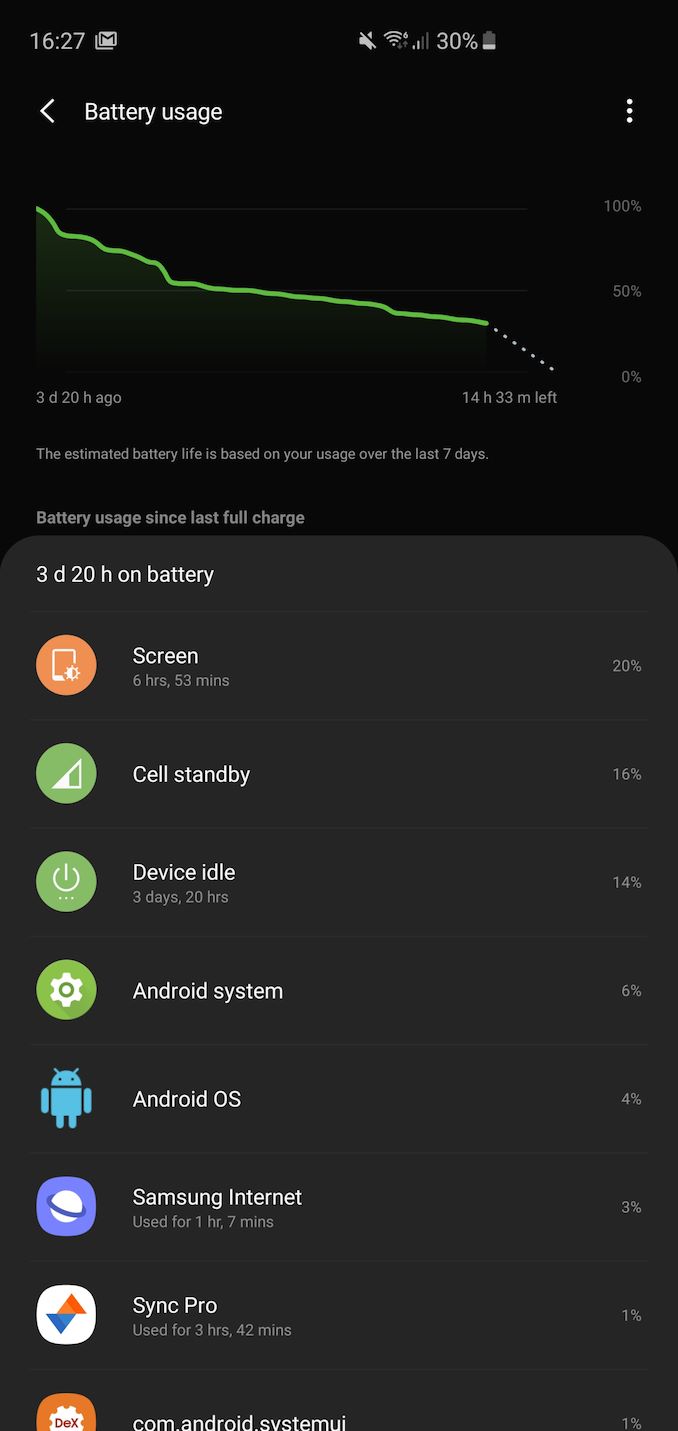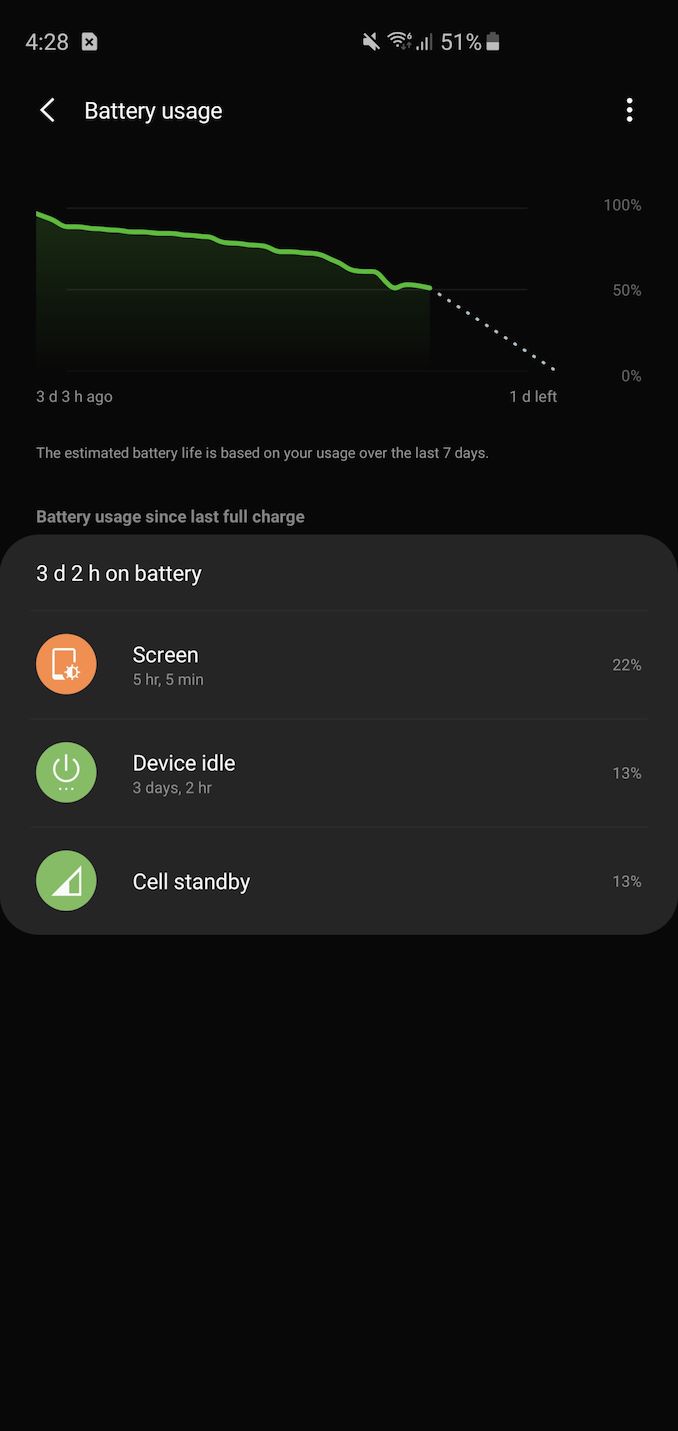The Samsung Galaxy S10+ Snapdragon & Exynos Review: Almost Perfect, Yet So Flawed
by Andrei Frumusanu on March 29, 2019 9:00 AM ESTBattery Life: Impressive
Battery performance of the Galaxy S10+ has been touted to be as class-leading. The introduction of a larger battery, more efficient screen as well as a new generation of SoCs are sure to bring improvements over last year’s Galaxy S9. One aspect that readers will have waited for impatiently is our testing of the new Exynos 9820 variant against the Snapdragon 855, which has also been one topic I’ve been extremely interested to see.
We run Samsung's Galaxy devices at the full potential they can deliver, something we've done for several generations now. This means that the screen resolution is set to the native 1440p of the display panels, and the new battery settings on the S10 were also set to "Performance" mode.
Without further ado, let’s get do the results:

In our web browsing test, both Galaxy S10+s are showcasing outstanding longevity at 13.08h for the Exynos and 12.75h for the Snapdragon variant. Least to say, I was extremely surprised to see this result even though we measured the Exynos 9820 CPU to be quite less efficient than the Snapdragon 855 in peak performance efficiency. I would have not expected the Exynos to match the Snapdragon, much less slightly beat it.
Before going into more details, let’s see the PCMark battery test results:

Here, in absolute terms, the Galaxy S10+ aren’t quite as impressive as on the web test and further lag behind the excellent results of the Kirin 980 devices. Nevertheless, these are some impressive figures and again it’s very good to see that both units are almost evenly matched, this time the Snapdragon unit lasting slightly longer than the Exynos.
To explain these results, we have to keep one thing in mind: the Exynos unit will have posted worse performance than the Snapdragon, so it will have spent more time at the lower more efficient frequency states.
One thing that I also noticed, is that in very low idle loads where there’s just some light activity on the A55 cores, the Exynos 9820 variant actually uses less power than the Snapdragon unit. The figures we’re talking about here are 20-30mW, but could possibly grow to bigger values at slightly more moderate loads. It’s possible that Qualcomm has more static leakage to deal with on the 7nm process than Samsung on 8nm, one thing that I’ve come to hear about the TSMC 7nm node.
Furthermore, one of the biggest improvements for the Galaxy S10 over past devices isn’t actually the SoC nor the actual bigger battery. It’s actually the display as well as the base power consumption of the phone. In Airplane mode, the base power has gone down by almost 100mW compared to the Galaxy S9+ which is a fantastic development and is especially something that will result in higher low-brightness battery life.
Currently in my time with both S10+ units, I can say they’ve been among the longest lasting Android devices I’ve tested.


Exynos vs Snapdragon in identical usage patterns & Prolonged idle periods
One issue I can confirm with the Exynos unit is that after a voice call in any app, the phone isn’t correctly entering its lower power state, and will suffer from increased idle battery drain until a reboot. This is something that hopefully Samsung addresses in a firmware update as it doesn’t look to be a hardware related issue. When not affected by this bug, both phones idle very similar to each other and slightly better than the S9+ I use as my daily device.










229 Comments
View All Comments
Liquidalloy - Friday, March 29, 2019 - link
That's why you should buy the unlocked variant. Right now I have the Verizon version of the s10 plus and there's very little bloatware. The phone is lightning fast btw.Jedi2155 - Friday, March 29, 2019 - link
As the bloatware typically doesn't impact my daily usage of the device nor consume a significant portion of the RAM/storage, I don't mind it. I actually find myself using much of the "extra" bloat they provide with the option to disable the ones I don't.When I use a stock AOSP build, I'm always searching for a feature or function that comes standard on Samsung....
0ldman79 - Saturday, March 30, 2019 - link
Go in and disable it.If you're really serious, root it, kill it and be done with it.
The Galaxy line have good hardware. Software can be dealt with.
I didn't buy my laptop for Windows 10, nor can I control what Dell puts on it, but I can certainly take it off.
SetiroN - Saturday, March 30, 2019 - link
Yeah, good luck formatting and installing a stock OS from an iso like you can with your dell laptop.What an asinine comment.
Shekels - Tuesday, April 2, 2019 - link
Dude have you ever rooted a phone? That's literally what you can do. Not an ISO but flash a Zip file and completely change your OS. The S10 is new and is pretty locked down, but some devs have already managed to root the thing and in the next couple months custom ROMs will emerge. It was like that for many Samsung phones on the past. The devs over at XDA have always manage to get root and custom ROMs on Samsung phones despite their attempts and totally locking down the phone.What an ignorant comment.
luisxfx - Monday, April 1, 2019 - link
I used to think the same thing, still kinda do, but I just hide or disable their icons, doesn't really make a difference, Galaxy S9 still runs smooth and quick.nathanddrews - Friday, March 29, 2019 - link
I upgraded from my S5 to the S10e at launch (T-Mobile, S855, 6GB/128GB). To be really honest, I was disappointed out of the box. The higher power button, locked bixby button, bloatware, default camera/video settings.The first real improvement I noticed was that all my apps opened instantly as opposed to waiting several seconds on my S5 (it was old and slower than when new, despite resetting the OS and trying difference ROMs).
The second improvement was the ridiculous battery life. I'm not a "power user" when it comes to cell phones. Text/email, pictures, videos, podcasts/music, and some web browsing. But still, 60% battery life at the end of every day (15hrs without charging) amazes me.
Now after a month of tweaking everything to my liking, I'm really happy with the phone overall. The speaker quality is really impressive - it's super loud without distorting much. The screen auto-brightness has adapted to my settings per app and depending on ambient light. The camera is only slightly disappointing. I must not hold the camera still enough, because a lot of my shots end up blurry/smeary when zooming in. I still need to work on dialing in those settings and trying some other camera mods.
nathanddrews - Friday, March 29, 2019 - link
I forgot to add that it felt a lot smaller in my hand (that's what she said) than my S5 due to the smaller overall bezel width. Now it's a lot more comfortable to use.Targon - Friday, March 29, 2019 - link
I also made the jump from the S5 to the S10, though I went with the regular S10, not the e. Not a single issue for me in any way(Snapdragon version, AT&T version). While there is still a fair amount of pre-installed apps, it doesn't feel as bloated as the S5 did with true garbage that I would never use but could not be uninstalled.liteon163 - Friday, March 29, 2019 - link
Part of your battery life issue could be due to an old battery in the S5. But manufacturers and Google certainly seem to plan obsolescence - ever higher specs are needed to keep up with the OS and bloatware.